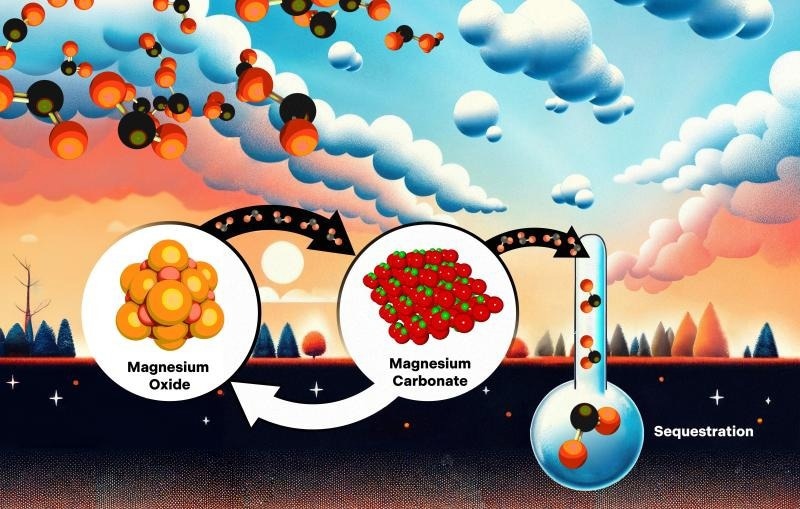One potential substance for directly extracting carbon dioxide from the atmosphere and depositing it underground to mitigate the consequences of climate change is magnesium oxide. However, to make the process cost-effective, it will be necessary to determine how quickly carbon dioxide is absorbed as well as how the surrounding environment influences the chemical processes.
 In a proposed carbon-capture method, magnesium oxide crystals on the ground bind to carbon dioxide molecules from the surrounding air, triggering the formation of magnesium carbonate. The magnesium carbonate is then heated to convert it back to magnesium oxide and release the carbon dioxide for placement underground, or sequestration. Image Credit: Adam Malin/ORNL, US Dept. of Energy
In a proposed carbon-capture method, magnesium oxide crystals on the ground bind to carbon dioxide molecules from the surrounding air, triggering the formation of magnesium carbonate. The magnesium carbonate is then heated to convert it back to magnesium oxide and release the carbon dioxide for placement underground, or sequestration. Image Credit: Adam Malin/ORNL, US Dept. of Energy
To measure the reaction rates, researchers at the Department of Energy’s Oak Ridge National Laboratory examined two sets of magnesium oxide crystal samples that had been exposed to the environment for varying lengths of time: days, months, and decades. They discovered that a reactive layer that accumulates on the surface of the magnesium oxide crystals causes carbon dioxide to be absorbed more slowly over extended periods.
This reacted layer is a complicated mix of different solids, which limits the ability of carbon dioxide molecules to find fresh magnesium oxide to react with. To make this technology economical, we are now looking at ways to overcome this armoring effect. If we can do so, this process might be able to achieve the Carbon Negative Energy Earthshot goal of capturing gigaton levels of carbon dioxide from air for less than $100 per metric ton of carbon dioxide.
Juliane Weber, Project Principal Investigator, Oak Ridge National Laboratory
Rather than using materials testing, most earlier research, which sought to determine how quickly the chemical interactions between magnesium oxide and carbon dioxide occur, was based on imprecise estimates. This multidecade test to find the response rate across extended time scales has never been done before, according to the ORNL research.
The researchers discovered that a reactive layer formed at ORNL’s Center for Nanophase Materials Science, or CNMS, using transmission electron microscopy. Several intricate crystalline and amorphous hydrated and carbonate phases make up this layer.
Additionally, by performing some reactive transport modeling computer simulations, we determined that as the reacted layer builds up, it gets better and better at blocking carbon dioxide from finding fresh magnesium oxide to react with. Thus, going forward, we are looking at ways to bypass this process to allow carbon dioxide to find fresh surface with which to react.
Vitaliy Starchenko, Researcher, Oak Ridge National Laboratory
Computer simulations assist scientists and engineers in understanding how the reactive layer grows and modifies the way substances pass through it over time. Predictions about the interactions and movement of materials in natural and artificial systems, such as materials sciences and geochemistry, can be made using computer models.
The study was principally financed by the DOE Office of Science. Time-of-flight, or TOF, secondary ion mass spectrometry, or SIMS, and preliminary transmission electron microscopy, or TEM, were all sponsored by ORNL’s Laboratory Directed Research and Development program. The CNMS, a DOE Office of Science user facility at ORNL, performed atomic force microscopy-TOF-SIMS and TEM characterizations as part of a user project.
Journal Reference:
Weber, J, et. al. (2023) Armoring of MgO by a Passivation Layer Impedes Direct Air Capture of CO2. Environmental Science & Technology. doi:10.1021/acs.est.3c04690